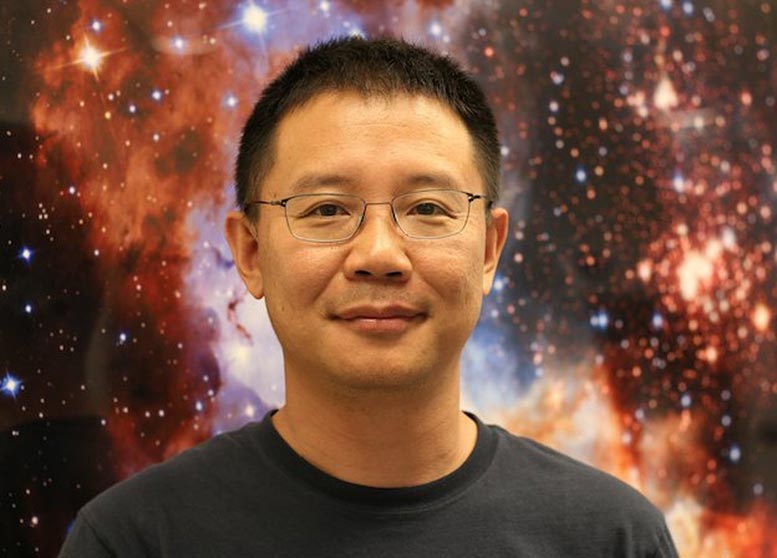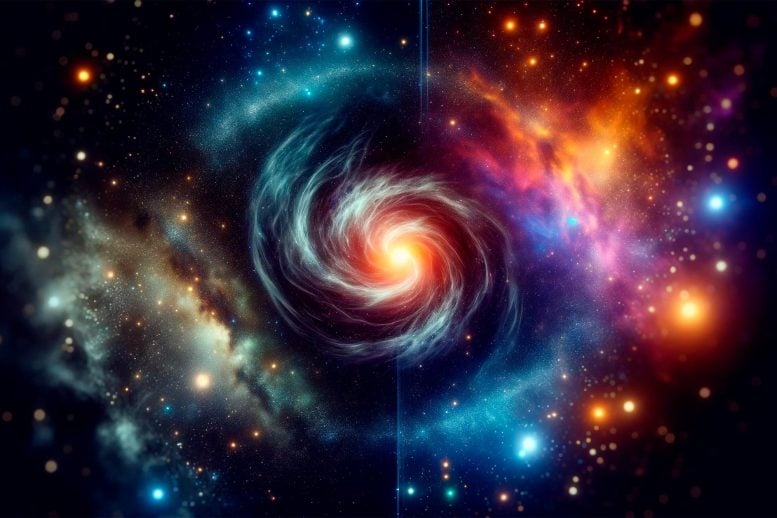Researchers have deepened their understanding of dark matter through simulations that support the theory of self-interacting dark matter (SIDM). This theory has the potential to resolve the inconsistency in observed dark matter densities in different galaxies, challenges traditional cold dark matter (CDM) models, and emphasizes the dynamic nature of dark matter. Image source: SciTechDaily.com
Research from the University of California, Riverside, reports that dark matter may be more active than previously thought.
Dark matter is thought to make up 85% of the matter in the universe, but it does not emit light and its nature is still unclear. While normal matter absorbs, reflects and emits light, dark matter cannot be seen directly, making it harder to detect. A theory called “self-interacting dark matter” (SIDM) proposes that dark matter particles self-interact through dark forces and strongly collide with each other near the center of galaxies.
Posted in this Astrophysical Journal LettersA research team led by Yu Haibo, a professor of physics and astronomy at the University of California, Riverside, reports that SIDM can simultaneously explain two extreme astrophysical puzzles.
Understanding Dark Matter Halos and Gravitational Lensing
“The first one is a high-density dark matter halo in a giant elliptical galaxy,” Yu said. “The halo was discovered through observations of strong gravitational lenses. Its density is so high that it is extremely unlikely to appear in the popular cold dark matter theory. Second, the density of the dark matter halo of ultra-diffuse galaxies is extremely low, making it difficult to use cold Dark matter theory to explain.”
A dark matter halo is a halo of invisible matter that permeates and surrounds a galaxy or galaxy cluster. Gravitational lensing occurs when light traveling through the universe from distant galaxies bends around massive objects. The cold dark matter (CDM) paradigm/theory assumes that dark matter particles are collisionless. As the name suggests, superdiffuse galaxies have extremely low luminosities and a diffuse distribution of stars and gas.

Haibo Yu is a theoretical physicist at the University of California, Riverside, with expertise in the properties of dark matter particles. Photo credit: Samantha Tieu
Yu was joined in the research by Ethan Nadler, a joint postdoctoral researcher at Carnegie Observatory and the University of Southern California, and Daneng Yang, a postdoctoral scholar at the University of California, Riverside.
To demonstrate that SIDM can explain these two astrophysical puzzles, the team performed the first high-resolution simulations of the formation of cosmic structures with strong dark matter self-interactions at relevant mass scales in strongly lensing haloes and ultradiffuse galaxies.
“These self-interactions lead to heat transfer in the halo, which diversifies the halo density in the central region of the galaxy,” Nadler said. “In other words, some halos have higher centers than their CDM counterparts. density, while other rings have lower densities at their centers, with the details depending on the cosmic history and environment of each ring.”
Challenging the CDM Paradigm and Future Research
The team stated that these two problems pose huge challenges to the standard CDM paradigm.
“The CDM faces the challenge of explaining these difficult questions,” Yang said. “SIDM is arguably a compelling candidate for reconciling two opposite extremes. There are no other explanations available in the literature. There is now the interesting possibility that dark matter may be more complex and dynamic than we expected.”
The research also demonstrates the power of using computer simulations of the formation of cosmic structures to detect dark matter through astrophysical observations.
“We hope our work will encourage more research in this promising research area,” Yu said. “This is a particularly timely development given the expected influx of data from astronomical observatories in the near future, including the James Webb Space Telescope and the upcoming Rubin Observatory.”
Since around 2009, the work of Yu and collaborators has helped popularize SIDM in the particle physics and astrophysics communities.
Reference: “Self-interacting dark matter solutions for extreme diversity in low-mass halo properties” by Ethan O. Nadler, Daneng Yang, and Hai-Bo Yu, November 30, 2023 Astrophysical Journal Communications.
DOI: 10.3847/2041-8213/ad0e09
This research was supported by the John Templeton Foundation and the U.S. Department of Energy.
#Emerging #dark #matter #theory #solves #astrophysical #mysteries
Image Source : scitechdaily.com
